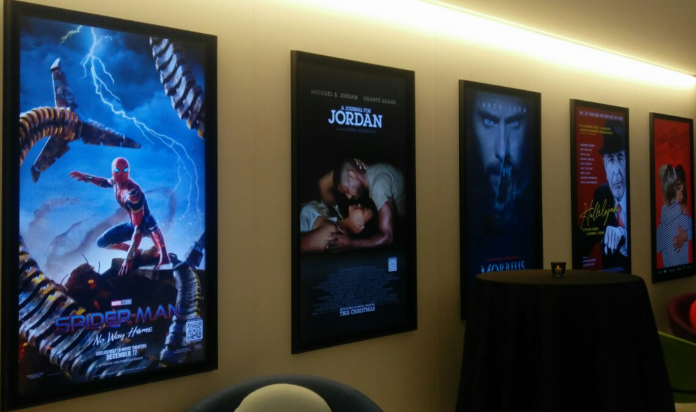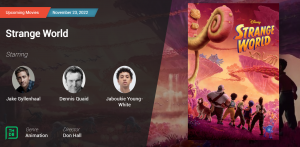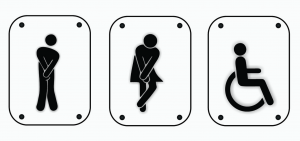After constant decline and a full halt during the Covid-19 years, movie theater recovery has accelerated in the past three months. According to recent numbers, moviegoers are eager to return to theaters in 2022, despite their tightening budgets. While this industry continues on the path to recovery, digital signage can help accelerate the process even further in ways which go beyond selling snacks and drinks. Movie theaters need digital signage not only to enhance the customer experience, but also bring customers to return to the theater after their visit. This ensures repeat visits and purchases, both of which help the industry get back on its feet.
Feature upcoming movies
Let’s start with the basics. Upcoming movies that don’t yet have a release date want to build up as much anticipation as possible to bring in more people. Give traditional movie posters an upgrade by deploying animated versions to make a greater impact. Exciting scene releases or any other visuals tied to the film are also worth considering. This type of material is a great fit for displays in movie theater lobbies to hype up an audience.
You can include audio with any visual content like this, but do keep in mind that playing multiple elements of this sort at once will be chaotic. It’s even worse for displays facing the outdoors. Because of these things, any movie theater should use audio with care, if at all. Meanwhile, subtitles are a must, especially when it comes to scene snippets. They will ensure the upcoming movie is presented well enough to build hype. This is precisely why movie theaters need digital signage software, to ensure everything runs smoothly and is easily set up.
Provide additional information
Unlike upcoming releases, movies that have a set date, especially if they’re happening soon, are a greater priority. It’s effortless to feature the basic movie information with the OnSign TV Upcoming Movies app, in the image below. Alongside the release date and showing time at a movie theater in your area, there is additional information to use which will excite the audience.
For a start, include short cast bios or even information that’s currently available about the main characters. Short one-liner fun facts are excellent sources of content. They may refer to the cast, production, or any behind-the-scenes information. But they may also cover information about movie characters, the world within the film, the era, mood, etc.
For sequels, remind viewers what happened in previous parts. This is a great way to keep them up to speed to enjoy the sequel, but to also subtly introduce new viewers to previous films. Naturally, any major spoilers should be avoided!
Help pass the time with interaction!
Interaction is easy to introduce in a movie theater, especially in the minutes before entering the screening room. Indeed, those 10 or 15 minutes when we arrive early for a film feel like an eternity. To pass the time, people will gladly interact with a display, read fun facts, answer trivia questions, and provide direct feedback! At the end of these fun games, include a single question which asks how they enjoyed their experience. Do they want to see more fun facts? Was the trivia quiz a neat pastime? See how the audience responds and adapt the content.
Another idea is to ask the user about their favorite movies or genre. Then provide a few recommendations for upcoming movies. For movies that don’t have a release date just yet, set a QR-code users can scan, or have them enter their email, or social media handle. This way, they’ll be notified once a movie they want to check out is showing at your theater together with screening times.
Wayfinding greatly enhances the experience
Small movie theaters don’t really need much in terms of wayfinding. But with larger ones, a bit of wayfinding goes a long way. Something as simple as a standard map of the theater helps moviegoers find their way. Adding digital signage to the mix, wayfinding can be brought up on demand on any nearby digital display.
An equally important location to highlight are the restrooms. In this case, wayfinding displays will be useful not only in the lobby, but throughout the building.
Take advantage of key moments
Most of the time, content on movie theater displays can’t be tailored to a specific audience. This makes total sense as you have no way of knowing what a random person walking in will want to see until they purchase a ticket. Luckily, digital signage can rotate a variety of content to ensure you reach as many audiences as possible. Meanwhile, there are some key moments when the audience type is very easy to establish.
An audience of people waiting to enter a showing of a horror film will clearly be interested in horror. Thus, featuring trailers and scenes from other films in this genre will make a greater impact and return the audience in the future. Another key moment happens once the movie finishes. At that precise moment, you’re getting 5-10 minutes of the same audience slowly walking out of the screening room and through the lobby. Just for that short window of time, you know precisely what the audience likes. For these few minutes, have your displays feature other movies from the same genre, or even provide a quick interactive pop-up asking them to rate the movie. All these things highlight why movie theaters need digital signage software by their side!
The possibilities are endless!
The basic framework for digital signage use exists in every movie theater. Adding creativity to the mix makes all the difference, especially with interactivity. Take advantage of the key moments mentioned above and schedule content to show at precise times to make the greatest impact on the audience. Furthermore, based on what the movie theater has to offer, segment the screen into sections, showcasing trailers, movie information, and interactivity at the same time. With time, streamline the process and see what setup local audiences respond to the most.
All these things are possible with a bit of magic through digital signage software. For a start, OnSign TV’s Dynamic Compositions and apps are the perfect tool to achieve it. Try them out, along with everything else on the platform, for free!







